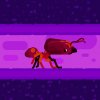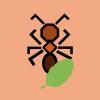- Formiculture.com
- Forums
- Gallery
- Members
- Member Map
- Chat

When do Ponera fly?
Started By
OwlThatLikesAnts
, Aug 24 2024 8:21 AM
6 replies to this topic
#1
 Offline
-
Posted August 24 2024 - 8:21 AM
Offline
-
Posted August 24 2024 - 8:21 AM
During the day, I find so many dead ponera queens everywhere, and I do not know at what time of day they fly because I want to collect some queens and I am aware that they fly until October . Please give me some info on what time of day they fly and where to find them
(I am in Quebec and I know what species they are)
(I am in Quebec and I know what species they are)
Currently keeping:
1x Formica subsericea, 20+ workers + a decently sized brood pile (35-40)
1x Crematogaster cerasi 3 workers with brood (been going all winter)
*As you watch your ants march, remember that every thing begins with a small step and continued by diligence and shared dreams*
-A.T (Me)
#2
 Offline
-
Posted August 24 2024 - 1:34 PM
Offline
-
Posted August 24 2024 - 1:34 PM
The only species of ponera I could find that has nuptial flight this time of the year is P. coarctata. I couldn't find a specific time of day they fly, but they should have flights in september too, so keep looking! Also, is it getting cold there in Quebec? It could be that the ants have nuptial flight in the evening and then die from the cold during the night.
And if you do catch one, I found a previous topic about raising Ponera in Formiculture: https://www.formicul...a-colony-going/
#3
 Offline
-
Posted August 24 2024 - 2:30 PM
Offline
-
Posted August 24 2024 - 2:30 PM
OwlThatLikesAnts, on 24 Aug 2024 - 4:21 PM, said:
During the day, I find so many dead ponera queens everywhere, and I do not know at what time of day they fly because I want to collect some queens and I am aware that they fly until October . Please give me some info on what time of day they fly and where to find them
(I am in Quebec and I know what species they are)
I would recommend trying a black light. It's possible they fly at night, so setting up a light to catch some queens would be a good idea.
- Artisan_Ants and cooIboyJ like this
"Float like a butterfly sting like a bee, his eyes can't hit what the eyes can't see."
- Muhammad Ali
Check out my shop and cryptic ant journal! Discord user is bmb1bee if you'd like to chat.
Also check out my YouTube channel: @bmb1bee
#4
 Offline
-
Posted August 24 2024 - 4:02 PM
Offline
-
Posted August 24 2024 - 4:02 PM
bmb1bee, on 24 Aug 2024 - 10:30 PM, said:
OwlThatLikesAnts, on 24 Aug 2024 - 4:21 PM, said:
During the day, I find so many dead ponera queens everywhere, and I do not know at what time of day they fly because I want to collect some queens and I am aware that they fly until October . Please give me some info on what time of day they fly and where to find them
(I am in Quebec and I know what species they are)I would recommend trying a black light. It's possible they fly at night, so setting up a light to catch some queens would be a good idea.
yeah I have tried that, It worked a bit (lol) I can't get my hands on a better light, but The species is Ponera pennsylvanicus
- Artisan_Ants likes this
Currently keeping:
1x Formica subsericea, 20+ workers + a decently sized brood pile (35-40)
1x Crematogaster cerasi 3 workers with brood (been going all winter)
*As you watch your ants march, remember that every thing begins with a small step and continued by diligence and shared dreams*
-A.T (Me)
#5
 Offline
-
Posted August 24 2024 - 4:32 PM
Offline
-
Posted August 24 2024 - 4:32 PM
Approaching October, this species will be all over the place in certain areas, (like in mine). Sure you are up for the challenge? Heard that this species is insanely hard to found as they specifically need spring tails to eat (since they are obviously semi claustral) but if you can get them or have them then it shouldn’t be a problem. The main problem would be the housing though as test tubes aren’t ideal for this species (probably better success rate in natural setups where the queen digs her chamber). Good luck on finding them though!
Keeping:
3x - S. molesta (colonies and single queen) 1x - C. nearcticus (founding but no eggs) ![]() New!
New!
1x - C. chromaiodes (colony) 1x - C. subbarbatus (founding)
1x - F. subsericea (founding) 1x - T. sessile (mega colony)
3x - P. imparis (colonies)
2x - L. neoniger (founding)
Check out my C. nearcticus journal here: https://www.formicul...cticus-journal/
Check out my C. chromaiodes journal here: https://www.formicul...aiodes-journal/
#6
 Offline
-
Posted August 24 2024 - 4:48 PM
Offline
-
Posted August 24 2024 - 4:48 PM
Artisan_Ants, on 25 Aug 2024 - 12:32 AM, said:
Approaching October, this species will be all over the place in certain areas, (like in mine). Sure you are up for the challenge? Heard that this species is insanely hard to found as they specifically need spring tails to eat (since they are obviously semi claustral) but if you can get them or have them then it shouldn’t be a problem. The main problem would be the housing though as test tubes aren’t ideal for this species (probably better success rate in natural setups where the queen digs her chamber). Good luck on finding them though!
I doubt they're insanely hard to found. If they're anything like Hypoponera, they can be sustained off of fruit flies and small pieces of mealworm if you can't get many springtails. Plaster petri dishes with a thin layer of soil on top would be very useful for founding.
"Float like a butterfly sting like a bee, his eyes can't hit what the eyes can't see."
- Muhammad Ali
Check out my shop and cryptic ant journal! Discord user is bmb1bee if you'd like to chat.
Also check out my YouTube channel: @bmb1bee
#7
 Offline
-
Posted August 24 2024 - 5:04 PM
Offline
-
Posted August 24 2024 - 5:04 PM
OwlThatLikesAnts, on 25 Aug 2024 - 12:02 AM, said:
bmb1bee, on 24 Aug 2024 - 10:30 PM, said:
OwlThatLikesAnts, on 24 Aug 2024 - 4:21 PM, said:
During the day, I find so many dead ponera queens everywhere, and I do not know at what time of day they fly because I want to collect some queens and I am aware that they fly until October . Please give me some info on what time of day they fly and where to find them
(I am in Quebec and I know what species they are)I would recommend trying a black light. It's possible they fly at night, so setting up a light to catch some queens would be a good idea.
yeah I have tried that, It worked a bit (lol) I can't get my hands on a better light, but The species is Ponera pennsylvanicus
you don't need anything fancy. i use simple rayovac uv flashlights- they're right about exactly at 400nm, which is juuuuuust right for all insects, just about.
i combine both uv light and daylight bulbs and it attracts everything
Edited by mbullock42086, August 24 2024 - 5:05 PM.
1 user(s) are reading this topic
0 members, 1 guests, 0 anonymous users


















